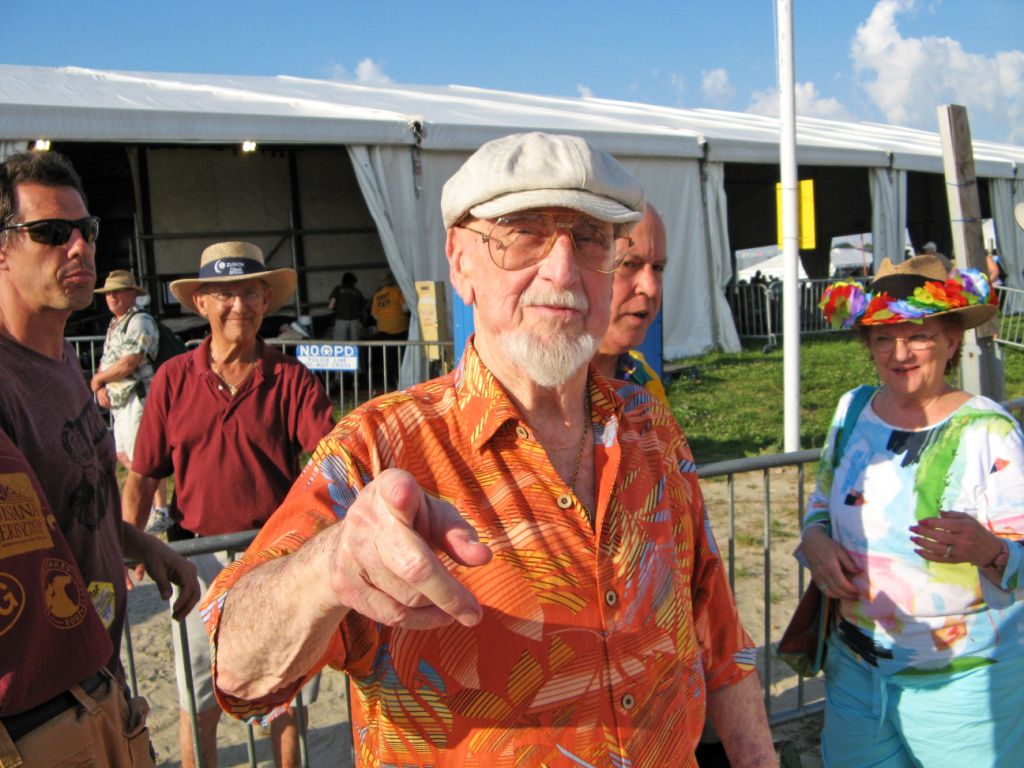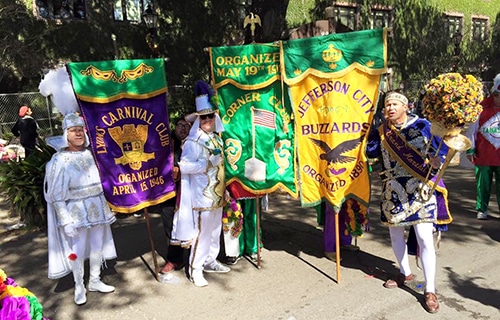By Sue Strachan, Uptown Messenger
In the early hours of Mardi Gras in Uptown, future revelers awaken to the sounds of walking clubs meandering through neighborhoods before the day’s parades roll.
In the Irish Channel, the Corner Club starts its stroll from its club at Annunciation and Laurel streets, while Lyons Carnival Club begins at Grits, at Lyons and Annunciation streets. The Jefferson City Buzzards commences from Laurel Street at Audubon Park. Further east in the Garden District, the Half-Fast Walking Club is awakening Commander’s Palace, with Mondo Kayo Social and Marching Club soon following it.
By city ordinance, only six walking clubs are issued permits for the St. Charles Avenue parade route on Mardi Gras, including these five clubs and the Baby Dolls, who walk with the Zulu parade. Why only six, research didn’t reveal, but it wouldn’t be hard to assume it has to do with keeping some semblance of order.
An New Orleans Item article from Jan. 30, 1923, about the upcoming Mardi Gras stated “smaller Carnival organizations, hitherto kept off Canal Street during Carnival, will be allowed to form a composite parade of their own to precede the Rex parade,” marking the first time the smaller groups marched together. Part of the discussion were the Corner Club, Garden District Club, Shakespeare Carnival Club and the Buzzards, who would “form a procession at 11:15 the morning of Mardi Gras and commencing at Lee Circle, follow the route of the Rex parade, but starting from opposite directions. Other Carnival clubs may join the parade.”

The Lyons Club on Mardi Gras 2019. (courtesy of the Lyons Carnival Club)
The clubs that march in 2020 are a reminder of the others that have since ceased: “the Eleanore Club, Garden District Carnival Club, New Era Club, Sixth District Carnival Club, Silver Leaf, Winning Hand, Liberty and Chrysanthemum Social Clubs, Tulane Pleasure Club, Jan Jans, Wampy-Wamps, Sons of the Res, Broadway Swells, St. Roch Minstrel Club, Sardonyn (spelled “Sardonyx” in a 1945 New Orleans Item story), Zele’s and Broad Street Carnival and Pleasure Clubs, Big Fifty Social Club of Gretna according to “New Orleans Masquerade: Chronicles of Carnival” by Albert Burton LaCour.
Other notable clubs included the Variety Merry Men, Little People’s Chowder and Marching Club, Arabi Carnival and Athletic Club, Lamplighter Club, Marching Fools Society, Delachaise Club, and Zig Zag Club, whose permit was taken over by Mondo Kayo.
Lyons, Buzzards and Corner Club are truly neighborhood institutions — in the past members lived there and stops on Mardi Gras often included familiar bars and friends’ homes before they made it to the parade route. As years passed, and people moved to the suburbs or out of town, membership was expanded to across the city to keep the clubs active. Fewer bars and people’s homes were visited by the groups, though today’s Krewe of Prytanians, helmed by Maria and David Huete, is a welcome beer and water stop at Napoleon Avenue and Prytania Street for the Lyons Club, Buzzards and Corner Club before they turn onto St. Charles Avenue.
Despite their rambling ways, the clubs have a somewhat set order on where they appear on the route: Half-Fast Marching Club and Mondo Kayo are before Zulu, while after Zulu and before Rex are Lyons Carnival Club, Jefferson City Buzzards and Corner Club, generally in that order, unless one of groups is having a big celebration and the Lyons Club lets them pass to take the front spot, according to a Lyons Club representative.
The history of each club is as individualistic as their routes.

The Jefferson City Buzzards on Annunciation Street (Uptown Messenger file photo)
Jefferson City Buzzards
Founded in 1890, Jefferson City Buzzards is the oldest of the groups. The clubhouse at 5213 Annunciation St. is in an area formerly called Jefferson City, because it was part of Jefferson Parish until 1870.
There are two stories for why they are called Buzzards. The first is that it was for the birds that frequented the area slaughterhouses near the river; the other, from “New Orleans Masquerade” states: “The choice was made because of the admiration of an older downtown club called the French Market Buzzards, which had disbanded.”
The Buzzards dress festively for the occasion, with members holding canes decorated with paper flowers to give to parade goers. The group starts at 7 a.m. at Laurel Street and Audubon Park.
The group even has its own theme song, “The Buzzard Parade,” composed by Armand Hug, who performed it in 1958 with the New Orleans Dixielanders on Art Ford’s Jazz Party on WDSU.
If you miss the Buzzards on Mardi Gras, the group also marches in the St. Patrick’s Day Parade and the Irish-Italian Parade, both in Metairie.

The Lyons Club in 1978 (courtesy of the Lyons Carnival Club)
Lyons Carnival Club
The club was organized on April 15, 1945, with the first meeting was attended by Charles Jennewine, Charles Siefker, L.H. Thevnot, Henry Pfeffer, Edward Partlan, Joseph Engelbracht Jr., Dominic Fallo and J.P. Kerth. The inaugural parade was Feb. 18, 1947, with Pfeffer as the first grand Marshal.
The club was based in a number of bars surrounding Wisner Playground and its vicinity: Kelly’s, Clancy’s (which started out as a grocery store), Norby’s and Graffagnini’s. Its spiritual home is now Grits Bar, on the corner of Lyons and Annunciation. It is where the club leaves Mardi Gras for the march.
Some of the establishments they peek their heads into on the march are the Buzzard’s Hall, Henry’s, Igor’s Buddha Belly, Ms. Mae’s and Fat Harry’s. Many were the same spots that the club stopped at for its practice march Feb. 9. (The Buzzards also have a practice march, as well.)
Membership changed through the years; for example, it absorbed the Eleonore Club. There are a number of members who are from out of town, and then there are natives, such as Mike Bullinger, who has been a member since he was a kid, when he was asked to be a junior officer.
In addition to handing out flowers from the day’s ubiquitous canes, this year’s 100 or so marchers will be accompanied by the New Creations Brass Band.
Miss them Mardi Gras? The group will also be in the Irish Channel St. Patrick’s Day Parade.

Corner Club members sometime after the club was revived in 1947. (Courtesy of the Lyons Carnival Club)
Irish Channel Corner Club Marching Club
The Irish Channel Corner Club was organized in May 1918 on the corner of Rousseau and Third streets, located in the heart of the Irish Channel neighborhood. The current clubhouse, a former grocery, is at Second and Annunciation streets.
For a brief period, the club disbanded during the Depression and through World War II, to return in 1947.
Membership, which now comes from all over, was originally drawn from the Irish Channel neighborhood, said Donald Schulz, who was grand marshal in 2004. Schulz recounted when he joined in 1973, he was considered an outsider from the 9th Ward.
The club marches twice during Carnival: the first in the Krewe of Thoth parade, the second, on Mardi Gras.
Club President Seann Halligan, a fourth-generation member, said there will be about 75 members for Thoth and 35 for Mardi Gras. New Orleanians will see a larger contingent, about 400, when they march in the Irish Channel St. Patrick’s Day parade.

Corner Club members in the Irish Channel Parade. (Zach Brien, Uptown Messenger)
For the Krewe of Thoth parade and Mardi Gras, the costumes are colorful and handmade locally every year by Karen Massett of Masquerade Costumes. They change with each year’s differing theme: this year’s is “Around the World,” which is incorporating black and gold for the New Orleans Saints and purple and gold for LSU, while also including red, white and blue, a result of allowing members to wear them – when they couldn’t after Thoth was rained out in 2019.
This year’s route will be a little different his year, according to the club’s website. The club will leave the hall at 7:30 a.m.,
Be sure to get a silk flower, koozies, garters, beads and special doubloons, which will depict the 2020 theme.
For the Thoth parade, the club has live music and a speaker system that rolls with them. The Big Fun Brass Band leads the parade, taking over about five years ago from Doc Paulin’s Marching Band, which had been doing it since the 1960s, according to Halligan.
The speaker system, which is also used on Mardi Gras, in the back, set up in “Taco’s Pee Wagon,” a converted truck which is the site for older members to ride in, a place for the beer and members to use the specially rigged urinal, when nature calls (and it will).

Clarinetist Pete Fountain, founder of the Half-Fast Walking Club (via Facebook)
Half-Fast Walking Club
With a start a Commander’s Palace at 7 a.m. and a finish somewhere, some time at the Hotel Monteleone in the French Quarter, the Half-Fast Walking Club makes the most of its stroll on the parade route.
The club was founded in 1961 by it best-known member, musician Pete Fountain, who had returned to New Orleans after a stint on “The Lawrence Welk Show” in Los Angeles.
The march created the perfect excuse to have a stroll on Mardi Gras day with some cocktails in hand and playing jazz. The original name was “The Half-Assed Walking Club,” though Fountain changed the name under pressure from the parade organizers.
Fountain died in 2016, but his spirit and club live on.

Uptown Messenger file photo
Mondo Kayo Social and Marching Club (via Facebook)
Mondo Kayo Social and Marching Club
If you see a group of marchers in Caribbean Carnival inspired costumes or in ensembles that are a creative interpretation of Carnival attire, it is most likely the Mondo Kayo Social and Marching Club, founded by Chuck Bush in 1982, according to its website.
In the parade’s early years, the group marched without a permit. Then one year the police waved them off the parade route and Bush almost got arrested. It was time to go legit, and Mondo Kayo got one of the treasured permits, which it took over from the Zig Zag Club.
Mondo Kayo, which has men and women members, follows Half-Fast Marching Club, and comes before Zulu. According to its website, the route starts at Third and Magazine streets.
Reporter Sue Strachan can be reached at suestrachan16@gmail.com.
